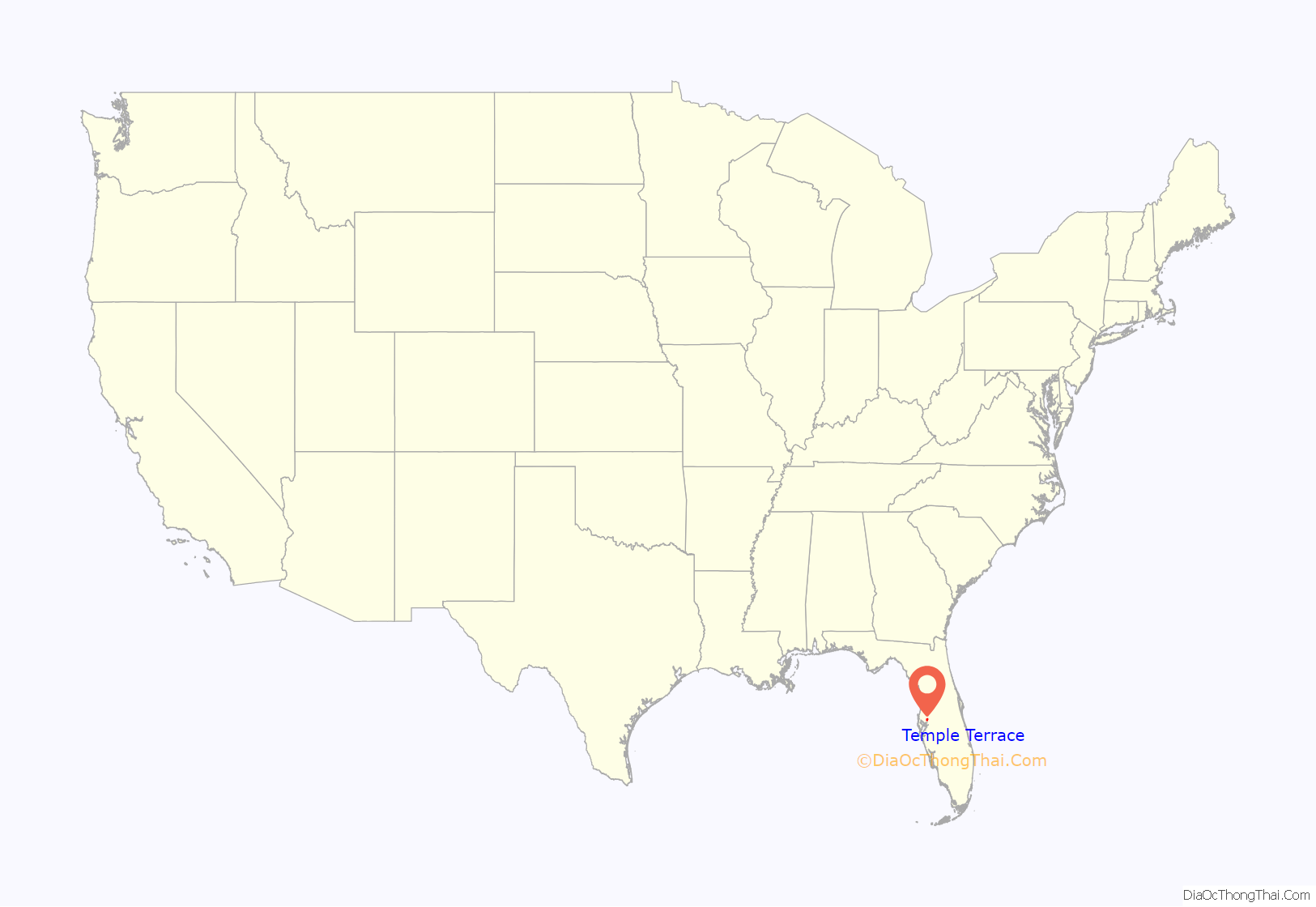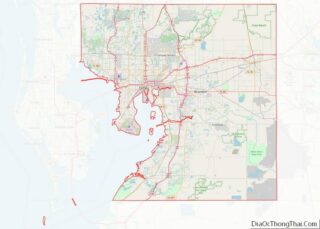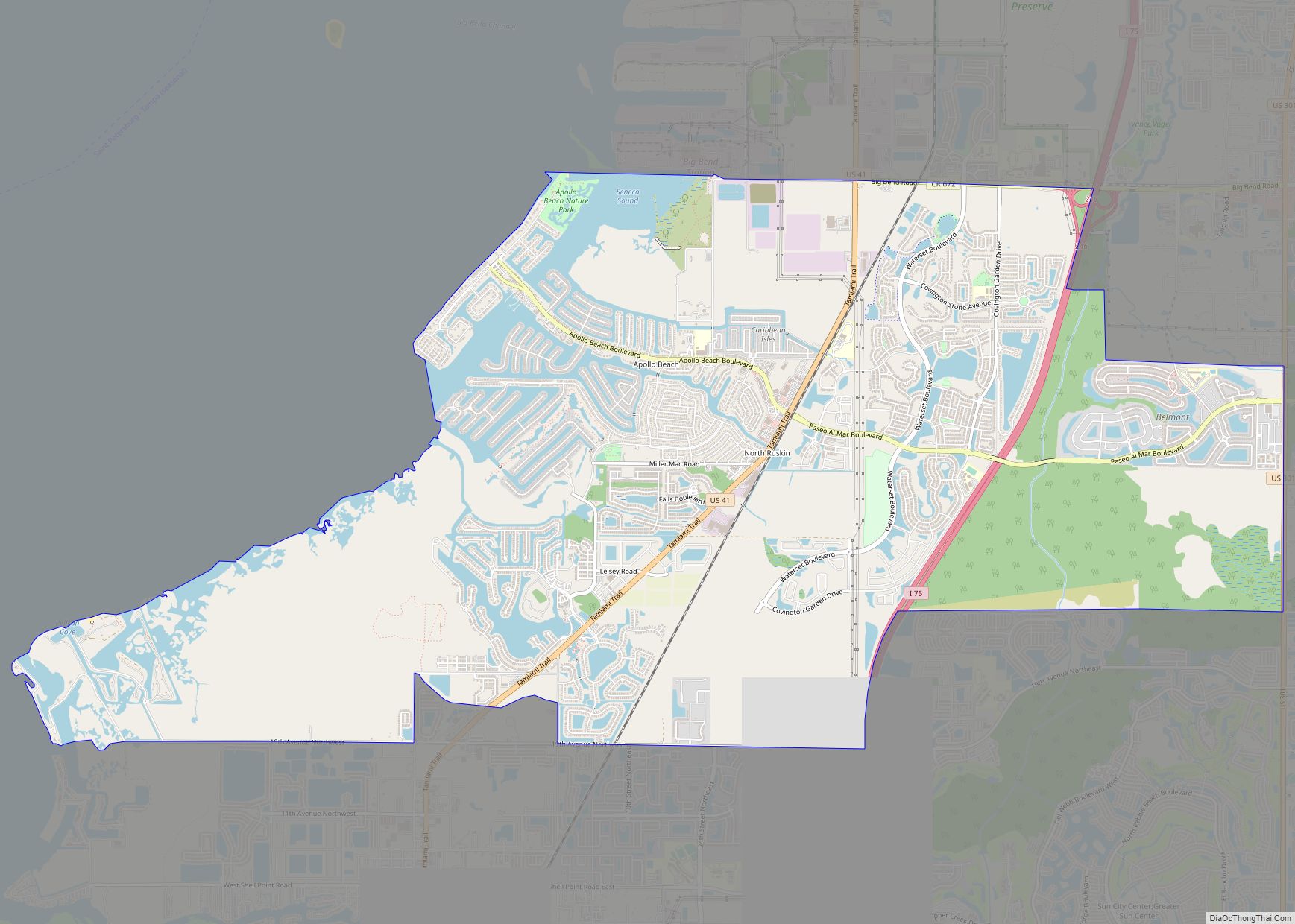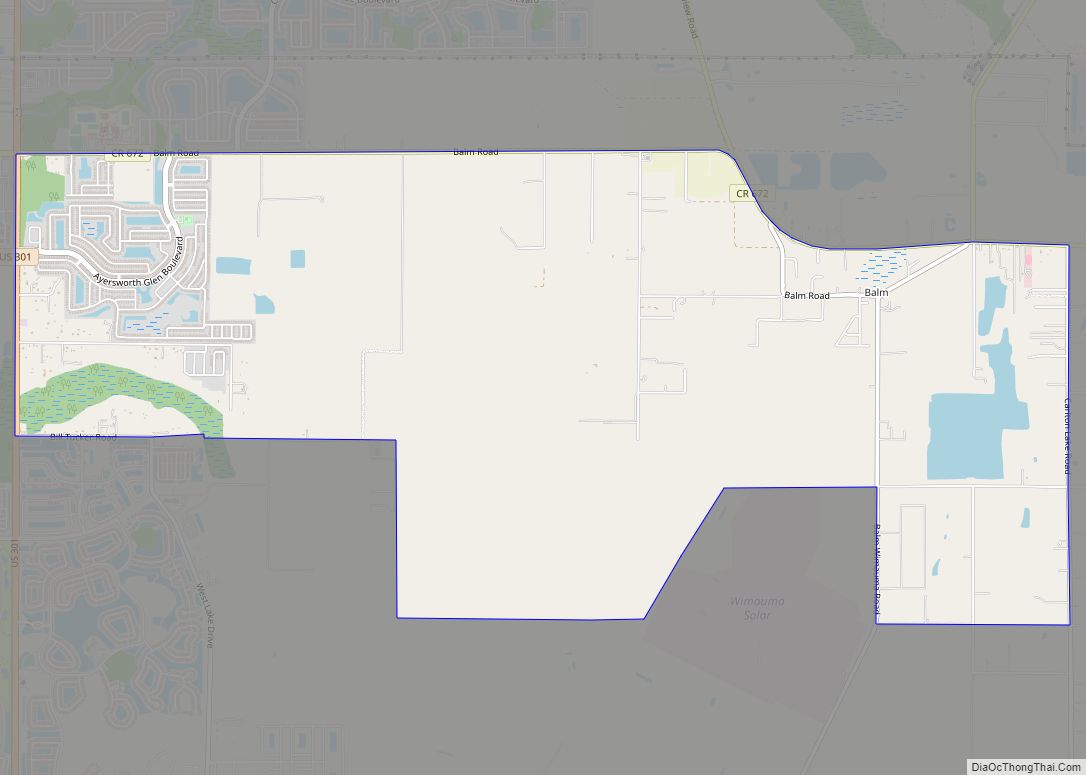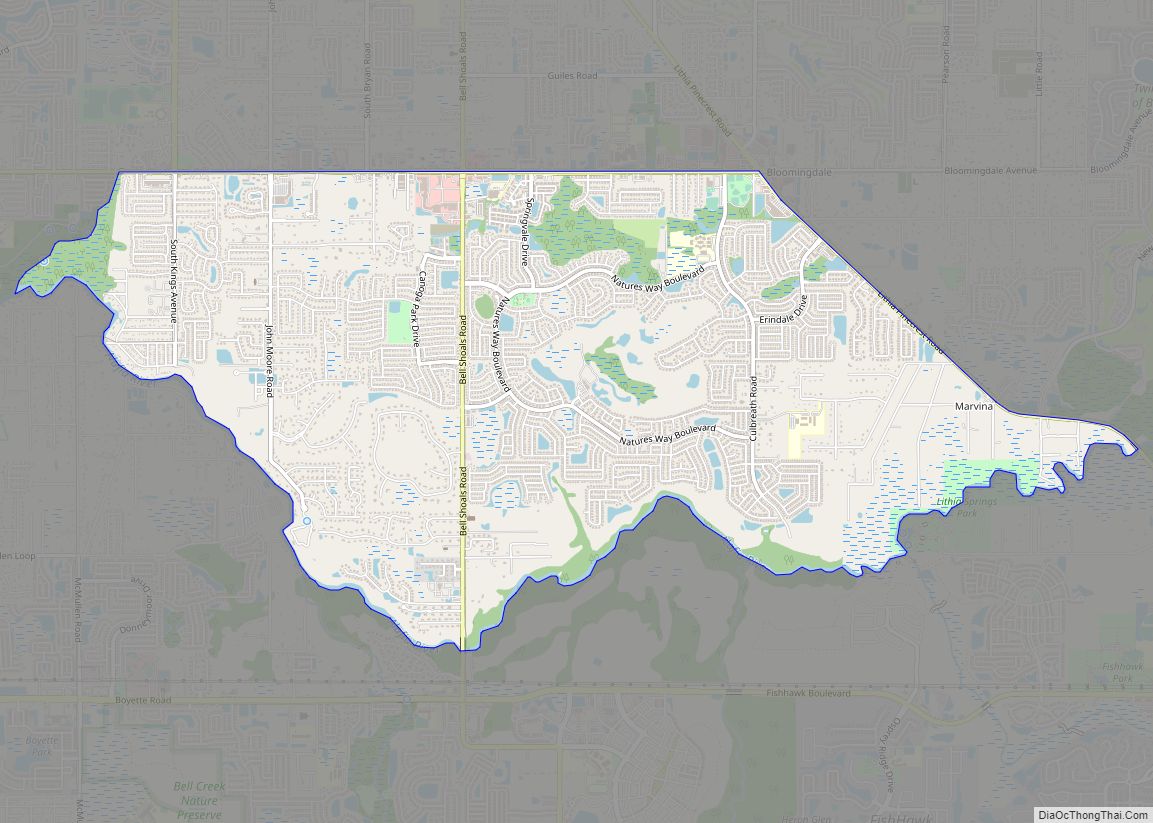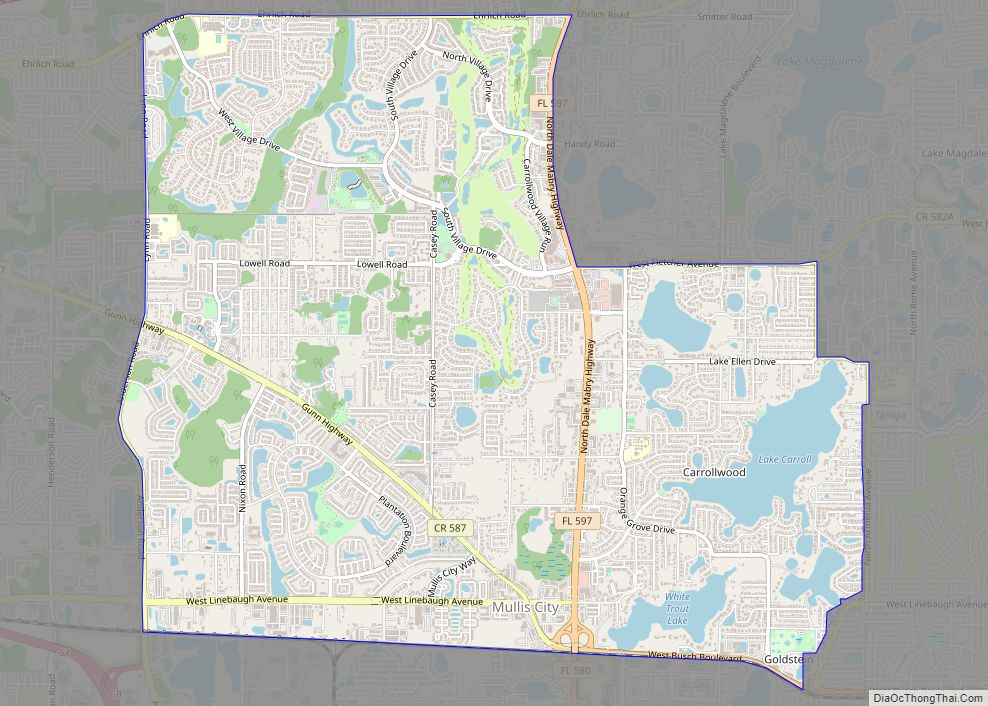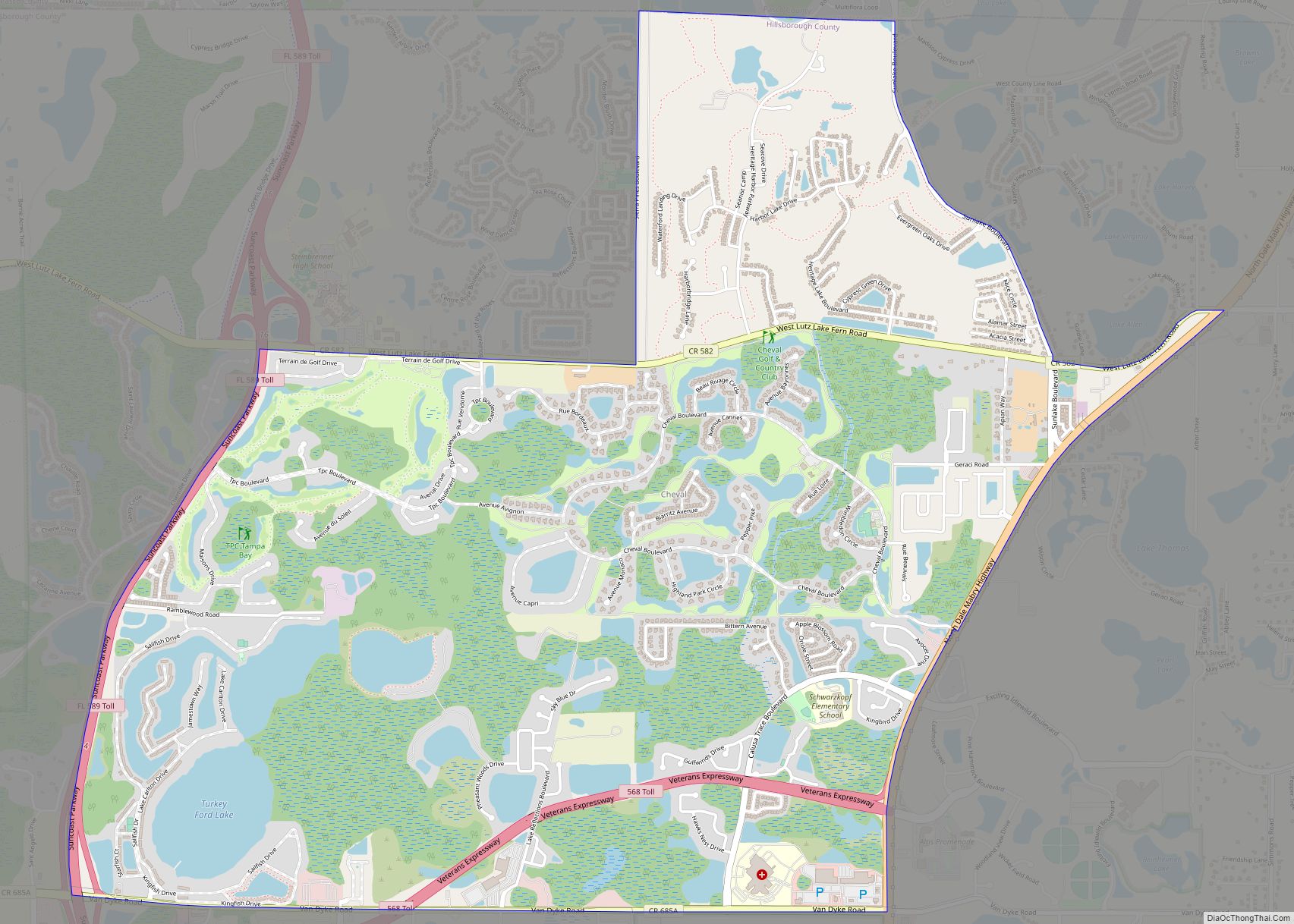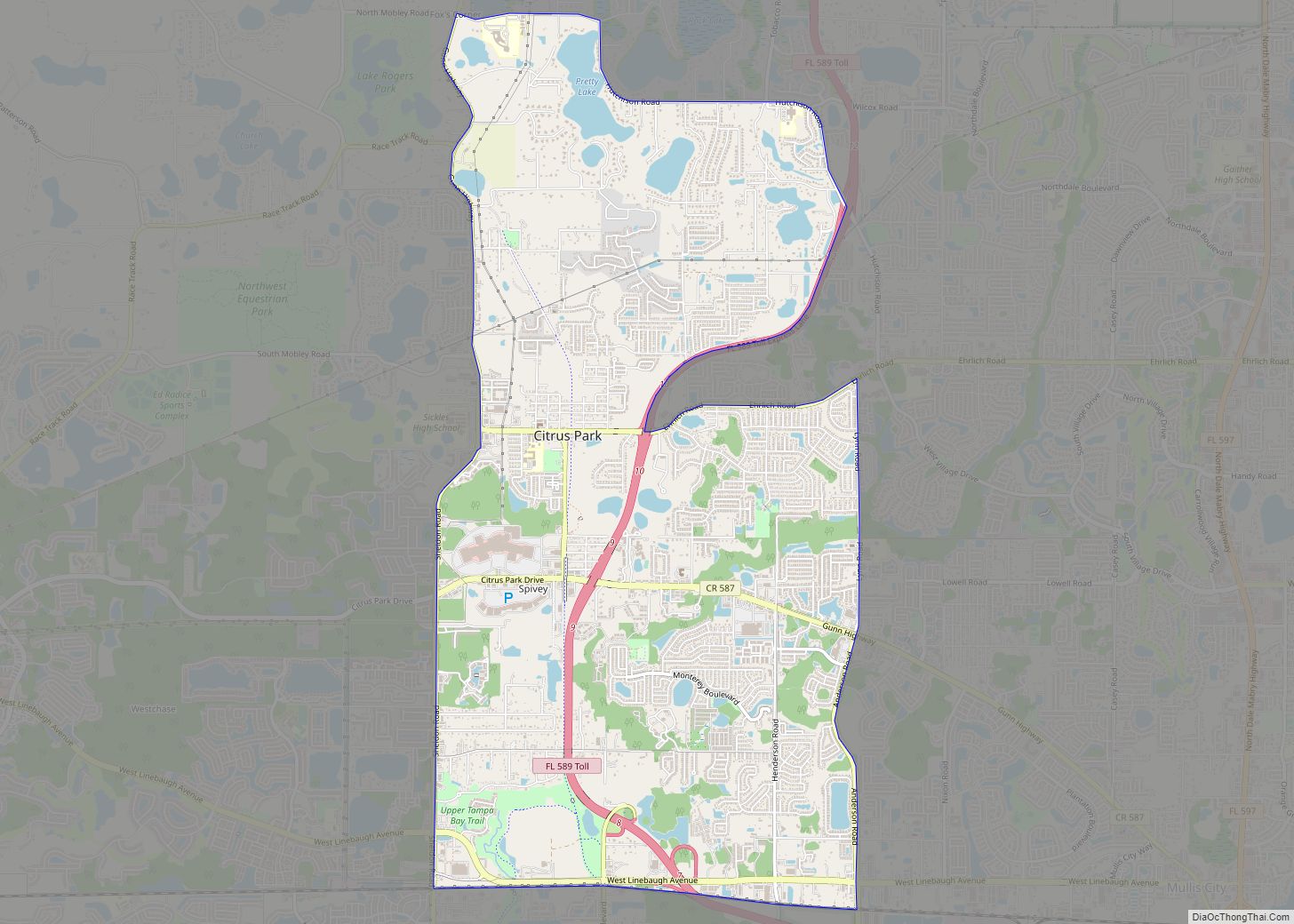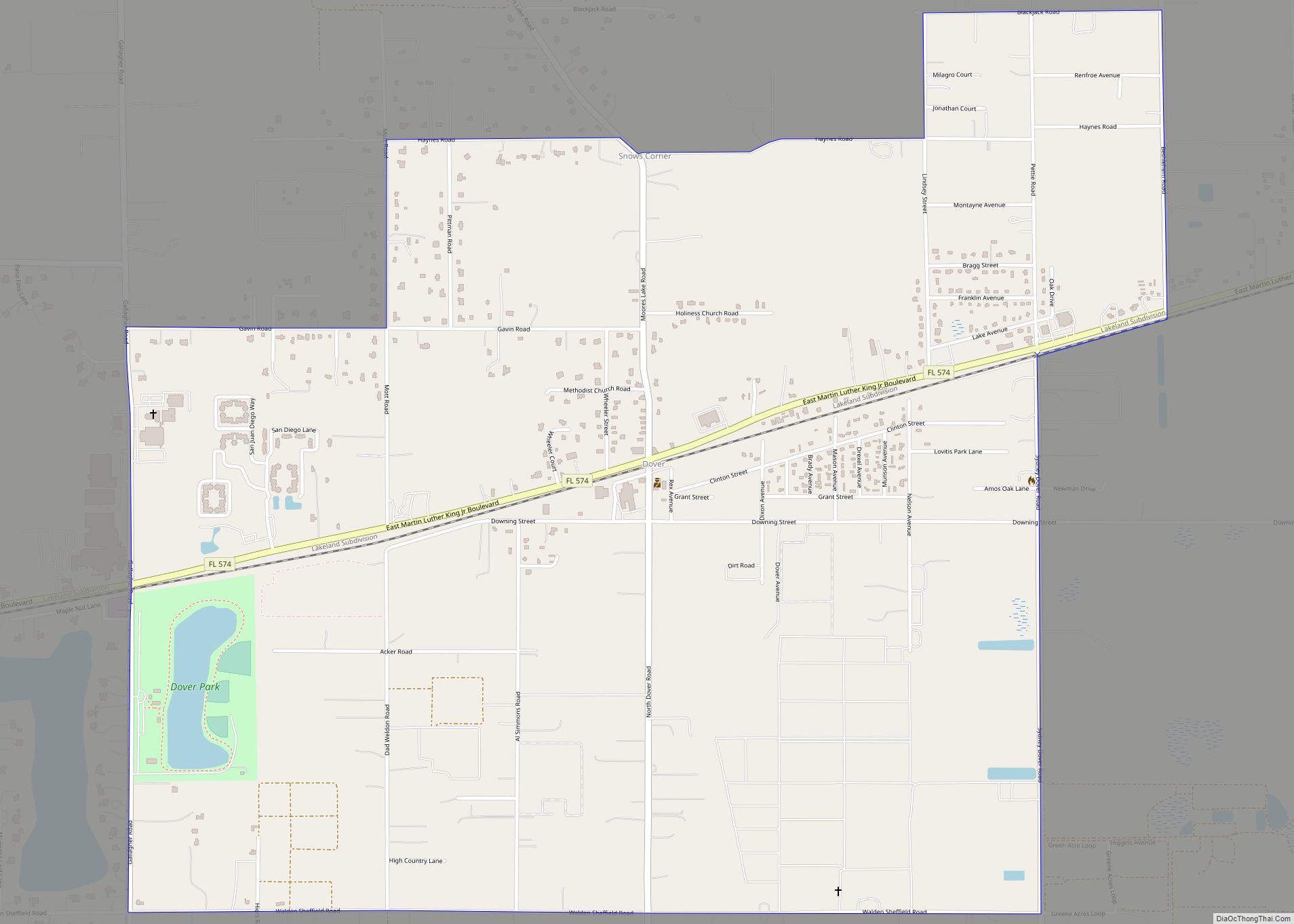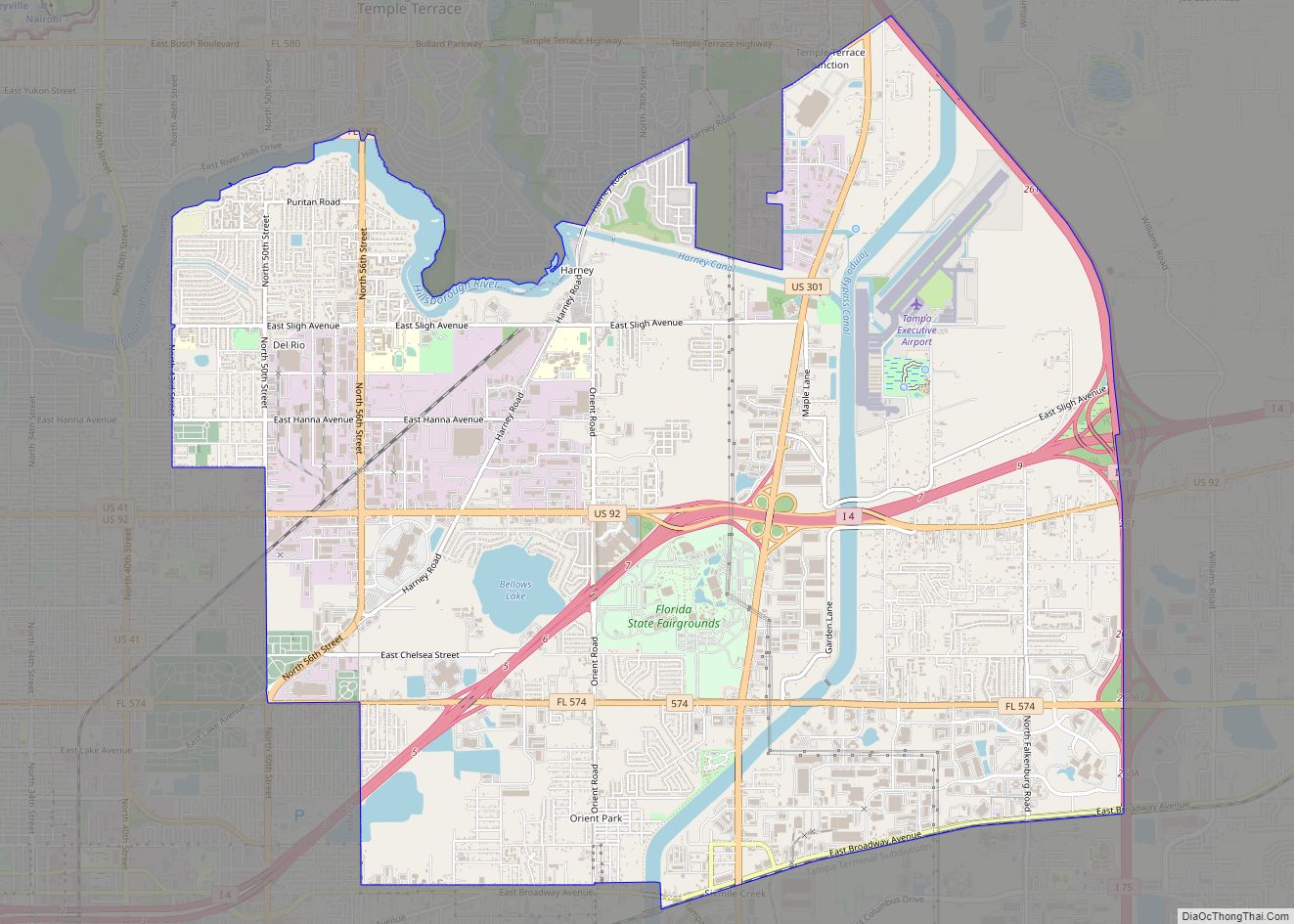Temple Terrace is an incorporated city in northeastern Hillsborough County, Florida, United States, adjacent to Tampa. As of the 2020 census, the city had a population of 26,690. It is the third and smallest incorporated municipality in Hillsborough County. (Tampa and Plant City are the others.) Incorporated in 1925, the community is known for its rolling landscape, bucolic Hillsborough River views, and majestic trees; it has the grandest sand live oak trees of any place in central Florida and is a Tree City USA. Temple Terrace was originally planned in the 1920s Mediterranean-Revival golf course community and is one of the first such communities in the United States (planned in 1920).
Temple Terrace was named for the then-new hybrid, the Temple orange also called the tangor. It is a cross between the mandarin orange—also called the tangerine—and the common sweet orange; it was named after Florida-born William Chase Temple, one-time owner of the Pittsburgh Pirates, founder of the Temple Cup, and first president of the Florida Citrus Exchange. Temple Terrace was the first place in the United States where the new Temple orange was grown in large quantities. The “terrace” portion of the name refers to the terraced terrain of the area by the river where the city was founded. One of the original houses also had a terraced yard with a lawn sloping, in tiers, toward the river.
| Name: | Temple Terrace city |
|---|---|
| LSAD Code: | 25 |
| LSAD Description: | city (suffix) |
| State: | Florida |
| County: | Hillsborough County |
| Founded: | 1920 |
| Incorporated: | May 28, 1925 |
| Elevation: | 59 ft (18 m) |
| Total Area: | 7.77 sq mi (20.13 km²) |
| Land Area: | 7.47 sq mi (19.36 km²) |
| Water Area: | 0.30 sq mi (0.77 km²) |
| Total Population: | 26,690 |
| Population Density: | 3,570.57/sq mi (1,378.57/km²) |
| ZIP code: | 33617, 33637, (33687 P.O. Box) |
| Area code: | 813 |
| FIPS code: | 1271400 |
| GNISfeature ID: | 0292103 |
| Website: | www.templeterrace.com |
Online Interactive Map
Click on ![]() to view map in "full screen" mode.
to view map in "full screen" mode.
Temple Terrace location map. Where is Temple Terrace city?
History
Pre-Columbian
The original inhabitants of the Temple Terrace area were known as the Tocobaga, a group of Native Americans living around Tampa Bay, both in prehistoric and historic times, until roughly 1760. Their numbers declined in the seventeenth century, due at least in part to diseases brought to the New World by the Europeans, to which they had little natural resistance. All of the Florida tribes were also severely affected by the raids of Creeks and Yamasee during the late stages of the seventeenth century. In any case, the Tocobaga disappeared from history less than a hundred years later.
Spanish exploration
Spanish exploration of the Temple Terrace area dates back to 1757 when explorer Don Francisco Maria Celi of the Spanish Royal Fleet made his way up the Hillsborough River (naming it “El Rio de San Julian y Arriaga”) to what is now Riverhills Park in search of pine trees to use as masts for his ships. Here, in the extensive longleaf pine forest, he erected a cross in what he named “El Pinal de la Cruz de Santa Teresa” (the Pine Forest of the Cross of Saint Theresa). Confirmation of the fleet’s travels is found in its map and logbook. A historic marker and a replica of the cross erected to honor St. Theresa are found in Riverhills Park today. Up to 1913, the longleaf pine, sand live oak, and cypress trees made the area suitable for turpentine manufacturing and logging.
The Potter Palmer years
The area now known as Temple Terrace was originally part of an exclusive 19,000-acre (77 km) game preserve called “Riverhills” belonging to Chicago socialite Bertha Palmer, wife of businessman Potter Palmer. She played an extensive role in making Sarasota the “City of the Arts” that it is today. She was one of the largest landholders, ranchers, farmers, and developers in Florida at the turn of the twentieth century. The Evening Independent newspaper in 1918 described the preserve as “a well-stocked hunting preserve north of Tampa being one of the most attractive hunting grounds in the state.” Property acquisition by the Palmers and the Honorés began in 1910; only one of the original buildings from the preserve, now known as the Woodmont Clubhouse, remains. Because it escaped logging, the grounds of the clubhouse harbor some of the largest specimens of live oak and longleaf pine in the city.
The Mediterranean Revival golf course community
Mrs. Potter-Palmer’s vision for her property was that it be developed into a golf course community surrounded by extensive citrus groves, but her death in 1918 prevented her from fully realizing that vision. At her death, the trustee of her estate and brother, Adrian Honoré, sold her local land holdings to Burks Hamner,
Vance Helm, Maud Fowler, Cody Fowler, and D. Collins Gillett, who formed two development corporations: Temple Terrace Estates, Inc., which developed the golf course and residential areas; and Temple Terraces, Inc., which developed 5,000 acres (20 km) of orange groves that originally surrounded the city to the west and north, the largest orange grove in the world in the 1920s. (Adrian Honoré retained a seat on the board.) D. Collins Gillett oversaw Temple Terraces, Inc. and owned the first and largest citrus nursery in Florida, Buckeye Nurseries of Tampa. His father, Myron E. Gillett, thirty-first mayor of Tampa, was instrumental in popularizing the exotic hybrid Temple orange in the United States.
The 1920 vision for the community was that wealthy retired Northerners would purchase one of the lots in Temple Terrace, build a Mediterranean Revival villa on the lot and also purchase a parcel in the extensive adjoining citrus grove to either manage as a hobby or provide extra income. Temple Terrace was originally only occupied during “The Season” (which lasted roughly from December to the annual Washington Ball held at the clubhouse on February 22). For the rest of the year, the houses were cared for by caretakers until The Season came again and the homeowners returned.
In 1924, part of the 5,000-acre (20 km) area platted as the Temple Orange grove and called Temple Terraces, Inc. was developed into the present-day neighborhood of Temple Crest, immediately adjacent to Temple Terrace and its west, hugging the Hillsborough River. The land occupied by nearby Busch Gardens was also part of Mrs. Palmer’s original 19,000-acre (77 km) ranch.
In 1925 and 1926, the Temple Terrace Golf and Country Club (which is still in existence) hosted the Florida Open (in 1925 billed as the “Greatest Field of Golfers ever to Play in Florida”). “Long” Jim Barnes was the resident professional of the course at the time (James Kelly Thomson was the course’s first pro), and every major golfer of the day competed in the event except for Bobby Jones. Leo Diegel won the tournament. Jim Barnes’ friend Fred McLeod is also associated with the early days of the course. The golf-course architect was Tom Bendelow, who also designed Medinah Country Club’s Course #3 in Chicago, a 7,508-yard (7,385 m) golf course that has hosted three U.S. Opens (1949, 1975, 1990) and two PGA Championships (1999, 2006). The golf course of the Temple Terrace Golf and Country Club is virtually unchanged since its design by Bendelow and is eligible for the National Register of Historic Places. It measures 6,414 yards with a par of 72.
Temple Terrace is one of the first planned golf-course communities in the United States (1920). The town plan was created by town planner and landscape architect George F. Young, who also created the plan for nearby Davis Islands (Tampa) and McClelland Park (Sarasota), among others. The architecture was designed in the Mediterranean-Revival style by two different architects in two different periods. The first phase was in 1921 by noted Tampa architect M. Leo Elliott (Centro Asturiano de Tampa and Old Tampa City Hall) designed the initial houses and the public buildings. In 1926 renowned New York architect Dwight James Baum (architect of John Ringling’s Cà d’Zan, the Hotel El Verona in Sarasota, and the West Side YMCA in New York City) also designed residences in Temple Terrace.
There are fifteen houses and buildings designed by Elliott remaining in the city, the largest collection of his work anywhere. In addition, there are over 35 houses in the city designed by architect Dwight James Baum, which is thought to be the largest collection of his work in the Southeast.
Temple Terrace struggled through the 1930s like the rest of Florida. Building activity began to pick up again after World War II. There is now a fine collection of mid-century modern homes and buildings, at least two of which were designed by well-known architect Frank Albert DePasquale.
Temple Terrace Road Map
Temple Terrace city Satellite Map
Geography
Temple Terrace is located in north-central Hillsborough County at 28°2′30″N 82°22′57″W / 28.04167°N 82.38250°W / 28.04167; -82.38250 (28.041546, –82.382519). The city is bounded by Tampa to the west and north, Del Rio to the south, and rural Hillsborough County, near Interstate 75, to the east.
According to the United States Census Bureau, the city has a total area of 7.1 square miles (18.4 km), of which 6.8 square miles (17.7 km) are land and 0.3 square miles (0.7 km), or 3.70%, are water. The Hillsborough River flows through the eastern and southern parts of the city and forms some of its southern boundary.
See also
Map of Florida State and its subdivision:- Alachua
- Baker
- Bay
- Bradford
- Brevard
- Broward
- Calhoun
- Charlotte
- Citrus
- Clay
- Collier
- Columbia
- Desoto
- Dixie
- Duval
- Escambia
- Flagler
- Franklin
- Gadsden
- Gilchrist
- Glades
- Gulf
- Hamilton
- Hardee
- Hendry
- Hernando
- Highlands
- Hillsborough
- Holmes
- Indian River
- Jackson
- Jefferson
- Lafayette
- Lake
- Lee
- Leon
- Levy
- Liberty
- Madison
- Manatee
- Marion
- Martin
- Miami-Dade
- Monroe
- Nassau
- Okaloosa
- Okeechobee
- Orange
- Osceola
- Palm Beach
- Pasco
- Pinellas
- Polk
- Putnam
- Saint Johns
- Saint Lucie
- Santa Rosa
- Sarasota
- Seminole
- Sumter
- Suwannee
- Taylor
- Union
- Volusia
- Wakulla
- Walton
- Washington
- Alabama
- Alaska
- Arizona
- Arkansas
- California
- Colorado
- Connecticut
- Delaware
- District of Columbia
- Florida
- Georgia
- Hawaii
- Idaho
- Illinois
- Indiana
- Iowa
- Kansas
- Kentucky
- Louisiana
- Maine
- Maryland
- Massachusetts
- Michigan
- Minnesota
- Mississippi
- Missouri
- Montana
- Nebraska
- Nevada
- New Hampshire
- New Jersey
- New Mexico
- New York
- North Carolina
- North Dakota
- Ohio
- Oklahoma
- Oregon
- Pennsylvania
- Rhode Island
- South Carolina
- South Dakota
- Tennessee
- Texas
- Utah
- Vermont
- Virginia
- Washington
- West Virginia
- Wisconsin
- Wyoming
